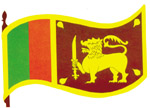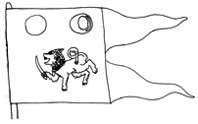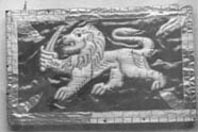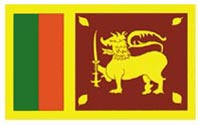The Lion Flag and its message of harmony
by Nemsiri Mutukumara
 Sri
Lanka steps into the 54th anniversary of regaining of independence from Britain.
In fact the country was ceded to Britain on a treaty called the Udarata Givisuma
in 1815, and with that episode the total control of the administration went into
the hands of the British.
Sri
Lanka steps into the 54th anniversary of regaining of independence from Britain.
In fact the country was ceded to Britain on a treaty called the Udarata Givisuma
in 1815, and with that episode the total control of the administration went into
the hands of the British.
However, the Portuguese and the Dutch had been controlling the maritime
provinces from 1505 and that year marked the dawn of the dark age in the near
3,000 years of freedom the people had enjoyed - freedom of movement, the freedom
from poverty, freedom of free education, freedom of indigenous cultural activity
and the freedom of religious worship.
On February 4, 1948, our people celebrated in much grandeur and tremendous
hope that they once again become the rulers of the land of their birth.
In the previous year, 1947, with the promulgation of the Soulbury
Constitution, Sri Lanka was granted self-rule and Parliamentary General Election
was held on 19 days from August 23 to September 20. Mr. D. S. Senanayake became
the first Prime Minister of independent Sri Lanka.
On the triumphant historic first independence day, people across the country
from Kankesanturai to Kataragama and Puttalama to Potuvil celebrated the event
hoisting the 2,000-year-old Lion flag - the flag of a heroic and fearless
people.
The Lion flag was genuine symbol of unity, harmony and friendship of all
people - the Sinhala, Tamil and the Yonaka of the ancient time who are known as
Moors.
When, Duke of Gloucester representing his brother, King George VI of England,
came to Sri Lanka to officially declare Lanka's independence, a royal ceremony
was held at the Independence
Square in an improvised pavilion in the sprawling landmass near the Colombo
Race Course.
Several thousand people who thronged at the place witnessed the colourful
ceremony of the Lion Flag which had been used by King Dutugemunu and adopted by
Lanka's subsequent Kings and Queens and which was used by our last King Sri
Wickrama Rajasinha as his Royal Standard went up majestically on the flag staff
at the Independence Square heralding the birth of freedom of yet another Asian
nation.
Already Myamar, and India had achieved freedom from the British with of
course bi-furcating the Indian Sub-Continent into two with the creation of
Pakistan. Indonesia too had regained her freedom from the Dutch.
Flags have played an important part in human life since the beginning of
recorded history, says William Crompton, Director of the Flag Institute of
England in his book, 'The Observers Book of Flags.'
Over 2600 years ago the Buddha Sakyamuni had referred to in the Dhajagga
Sutra the use of flags. The flag is the identity of a nation, a country or a
kingdom.
The Lion Flag is considered the oldest national flag in the world.
Historically, the Lion Flag of King Dutugemunu is illustrated in the cave 2 of
the Golden Rock Temple of Dambulla the Rangiri Dambulu Viharaya.
In Dambulla, there are a number of caves. Professor Anuradha Seneviratne in
his book Golden Rock Temple of Dambulla, states, 'caves are donated to the
Buddhist monks as dwelling places by various persons such as Kings, Chiefs,
Buddhist monks and Nuns.'
Among the eight caves he has listed as important for understanding the
history, the cave No. 2 place centre stage. Illustrated in this cave is the Lion
Flag of King Dutugemunu.
Although a few petty minded critics used to attribute the Lion Flag to one
particular community, the fact of the flag is absolutely different from such
petty thinking. Says, Lion H.M. Mervyn Herath in his valuable book titled 'The
National Flag and the National Anthem of Sri Lanka History and Significance', in
the following words: "The heraldic Lion standing smartly holding a sword
upright by its right paw stands for justice and righteousness.
"Bordering this is a rectangular line with four bo-leaves at the four
corners symbolising Metta-compassion, Karuna-kindness, Mudita-joy in others
prosperity and Upeksha-equanimity called four Brahma Viharana or the highest
standards of harmonious living.
And that was the flag which fluttered from the flagstaff in front of the
sacred Dalada Mandiriya in Mahanuwara during the era of the Kings of Lanka.
On that fateful day, when the British had unfurled their Union Jack, Patriot
Prelate the Ven. Variyapola Sumangala brought down the flag of the imperialists
and tried to hoist the Lion Flag in its place.
For this brave, fearless and patriotic deed, the Ven. Sumangala was tried for
treason. After taking over the administration of the country on a convention,
the British took King Sri Wickrama Rajasinha's Royal Standard to England and
kept in the Royal Military Hospital Chelsea in London.
In bringing back Lanka's glorious Lion Flag, Mr. E.W. Perera, a member of the
Legislative Council and later the State Council left no stone unturned until the
British authorities returned to Sri Lanka what was her rightful and legitimate
possession. The Lion Flag came back to Sri Lanka to play an important part of
the re-dawn of freedom on February 4, 1948.
Almost all communities voiced their acclamation that the Lion Flag should
continue to be the national flag of free Sri Lanka.
The undisputable message of the Lion Flag was that it represented justice and
fair play, harmony and unity and bravery and heroism-peace and prosperity to
every living being not only human beings.
Arisen Ahubudu, one of Sri Lanka's eminent litterateurs, a historian,
grammarian, poet and writer describes the flag as the symbol of heroism.
"The Lion with the sword raised in its right hand denotes the onward
march of the people without any fear for the enemies of the nation. The colour
yellow denotes righteousness and peaceful way of life.
The red in the background of the heraldic lion with the sword denotes the
defeating of the evil forces of oppression. The nation and the people guided by
the message of the flag will never resort to provoke others. The four bo-leaves
on the four corners indicate exactly the truism of non-aggression. The people of
the Lion Flag never regress from their onward march until victory is achieved.
What a glorious heritage the Sri Lankan people had inherited over the last
two and half millennia.
Studying all these historic facts Mudaliyar A.L. Sinnalebbe Member of
Parliament for Madakalapuva in the Eastern Province (erroneously called
Batticaloa aping the Portuguese) moved in Parliament in January 1948, the
following motion:
"That this House is of the opinion that the Royal Standard of King Sri
Wickrama Rajasinha depicting a yellow lion passant holding a sword in its right
paw on a red background which was removed to England after the convention of
1815 should once again be adopted as the official flag of free Lanka".
So was another Muslim leader, Dr. M.C.M. Kaleel, the President of the
All-Ceylon Muslim League expressed in no uncertain terms that the Muslims would
be happy to retain the Lion Flag as the flag of independent Lanka.
After two years of deliberations the Lion Flag was accepted as the National
Flag of Sri Lanka by the special 'National Flag Committee' appointed by Prime
Minister D.S. Senanayake on March 6, 1948.
The Committee had Mr. S.W.R.D. Bandaranaike as the Leader of the House as
Chairman. The other members were Sir, John Kotelawala, Mr. T.B. Jayah, Dr. L.A.
(later Sir Lalita) Rajapakse, Mr. G.G. Ponnambalam and Senator S. Nadesan.
The report was signed by all six members with Senator Nadesan submitting a
dissent note.
However, the Committee had accepted the Lion Flag with a modification of
adding two vertical stripes of saffron and green for the minority communities.
This flag was thereafter hoisted by the people. Yet, its gradual popularity
was quite slow until the advent of President Ranasinghe Premadasa who caused
entrepreneurs to produce the Lion Flag in cloth, paper, and plastic as well.
From that time onwards, from the first week of January the Lion Flag became
the largest selling articles in shops and boutiques.
People of all walks of life, from the humble hut dweller to the palatial
Colombo seven mansion, the Lion Flag fluttered from their roof tops.
The three-wheeler to the luxury limousine had the Lion Flag flown during the
Independence week.
All schools public and private held flag ceremonies on February 3 since the
Independence Day was a national holiday.
Once again, all people everywhere are prepared to enjoy the unity and harmony
as one nation and one Sri Lankan community under the banner of the Lion Flag
which gives the message of peace and harmony.
Gold: represents intelligence, peace, non-violence and truth.
Crimson: represents immortality.
Four Bo-leaves: loving kindness, compassion enjoying the joy of others
happiness and equanimity.
The Lion: signifies heroism, strength, and discipline of the nation.
Head-ruler (shape of a crown); Eye - watches the rulers performance, Tongue: the
rulers statements should be honest and truthful, Head and Tail: equality between
ruler and the citizens, Hairy-heaps: denote strength, The Sword: is an
indication that the country should be ruled righteously meting out justice to
all.
The Lion flag -how it came to be
by CAROL ALOYSIUS - Sunday Observer Feb 10 2002
Sri Lanka's national flag is steeped in history and
tradition. From its hoary past to the present day, the events linked with this
national symbol of freedom and independence are so packed with drama, suspense,
and political intrigue that it could easily go down in history as one of the
most unique flags in the world.
 |
Dutugemunuís
flag which he carried after his victory over his enemies
|
 |
Copy of
the flag of the Kandyan Kings in the 18th century, made according to the
design of the original flag found in England.
|
 |
The flag
as it exists today.
|
Much of these fascinating and exciting events has however
been forgotten in the mists of time, and many of our younger generation are
unaware of the significance and importance of their National flag.
Many may not know that the birth of the Sinhala race began
with the planting of the Lion flag for the first time in Lankan history. Here is
how H.M. Herath describes this epoch making event in a recently published book
on the National flag and National anthem of Sri Lanka.
He writes: "In about 486 BC, Prince Vijaya, the
eldest son of Sinha Bahu, King of Sinhapura landed at Tammana with seven hundred
companions from his father's kingdom in North India. So delighted was he, that
he took a handful of sand and called it the land of the copper coloured sand,
and planted the flag they were carrying (a flag with a lion symbol). He then
kissed the sand and called it "Thambani." So began the history of Sri
Lanka, the birth of the Sinhala race."
If history had not yet begun to be written in Sri Lanka,
how do we know about this event? Replies the author, "The inscription of
this great and grand event on record is among the archaeological remains at the
Sanchi stupa, an ancient Buddhist monument built during the reign of Emperor
Asoka in the second century BC in the native state of Bhopal in India."
Since its arrival in Sri Lanka, the Lion flag has played a
significant role in the political history of the country. To our monarchs of
yesteryear it became a symbol of freedom and Hope. The warrior King Dutugemunu,
used the heraldic lion carrying a sword on his right forepaw with two other
symbols, the Sun and the Moon on his banner.
An illustration in the frescoes of the rock temple at
Dambulla which traces the beginning of the Lion flag of Sri Lanka shows the
victorious king proudly carrying his royal banner depicting the Lion symbol
after he freed his people from foreign invaders.
As Herath points out, the lion symbol was used by the
Lankan monarchs from the time of King Vijaya. This has been recorded in both the
Mahavamsa and the Chulavamsa. The last king to use the flag as a symbol of
national freedom was King Sri Vikrama Rajasinghe who was the last king of Sri
Lanka, and whose rule ended in 1815.
Commenting on the significance of the emblems on the Royal
Standard of Sri Vikrama Rajasinghe, Herath writes: "The heraldic Lion
standing holding a sword upright by its right paw stands for Justice and
Righteousness.
"Bordering this is a rectangular line with four Bo
leaves at the four corners, symbolising Metta, Karuna, Muditha, Upeksha, called
the 'Four Brahma-Viharana in Buddhist matbaphysics.
"The yellow border represents the Maha Singha who
played an important role in guiding kings in ancient times and directed and
participated in the emancipation of the country as recorded in the national
chronicles." He adds, "All these emblems, on a brilliant background of
crimson indicate immortality, and remained the Royal Standard of King Sri
Vikrama Rajasinghe, the last king of Kandy."
The ceremony in which the flag was replaced by the British
Union Jack was full of drama and colour. Describing it Herath writes: "The
Kandyan Convention was proclaimed at 3.30 p.m. on March 2, 1815, in the Audience
hall, then called the Magul Maduva of the Palace of Kandy.
This was signed by governor Robert Brownrigg on behalf of
His Royal Highness, the Prince Regent, on the one hand, and the Adigars,
Dissavas and other principal chiefs of the Kandyan Province. ...Outside, drums
were beating all around the hall. British troops guarded all the entrances to it
and also patrolled the streets. The treaty was next read aloud to the chiefs in
Sinhala and both parties agreed to its contents.
Then the Lion flag was hauled down and the Union Jack took
its place amidst salvoes of artillery and His Majesty King George III was
acclaimed King of Ceylon."
But the act of hoisting the British flag in place of the
Lion flag was premature, a violation of the law, as it was done before the last
Kandyan chieftains had signed the treaty, and prompted retaliation from the Maha
Sangha, a who were present on the occasion.
Herath re-enacts details of that suspenseful and dramatic
epoch making event." " From amidst the spectators who watched this
drama, stepped out a Buddhist monk, the Ven. Wariyapola Sumangala of the Asgiri
fraternity. Fortified with confidence, fortitude, self-respect and patriotism he
approached the English general to ask, "who gave you permission to hoist
your flag here?
You have no right to do so - Yet." He then proceeded
to pull down the Union Jack, trampled it and hoisted the Lion flag in its place.
Only after chief Adigar Ehelepola had signed the Convention with much reluctance
on March 10 that the Union Jack was hoisted."
Not many may know that the Royal standard of the last king
of Lanka languished in a military hospital in London after the British took
control of the Kandyan Kingdom.
According to Herath, it was removed to England by the
British Raj and kept in the Royal Military Hospital Chelsea in London until a E.
W. Perera, a staunch patriot also known as the Lion of Kotte, discovered it.
The first time the Lion flag became a centre piece of
attraction and the public became aware of the actual design of the flag
following the fall of the Kandyan Kingdom was when the Dinamina issued a special
edition of the paper on March 2, 1915 to mark the centenary of the end of
Sinhala independence, with the intention of re-kindling the desire of the people
to win back the freedom they had lost to the British, Herath states. He adds,
"On the front page were portraits of the last King and Queen of Kandy
surmounted by the royal insignia Crown and the Lion flag in colour.
This was the first time since the fall of the Kandyan
Kingdom that the people became aware of the actual pattern of their national
flag."
Although the Ceylon Independence Act 1947 passed by the
parliament of Britain stated that the flag of the British empire, the Union jack
would continue to take precedence over the Lion flag, the national leaders of
the time were openly opposed to such a decision.
Still, barely nineteen days prior to the dawn of
Independence Day, Lanka's first Prime Minister Mr. D. S. Senanayake's cabinet
had yet not taken a decision with regard to hoisting the National Flag on the
first independence celebrations of February 4, 1948.
It was left to Mudaliyar A. L. Sinnelebbe, the Member of
Parliament for Batticaloa to move a motion in parliament stating that,
"This house is of the opinion that the Royal Standard of King Sri Wickrama
Rajasinghe depicting a yellow lion passant holding a sword in its right paw on a
red background, which was removed to England after the convention of 1815, be
once again adopted as the official flag of free Lanka."
The flag was hoisted on that historic occasion amidst the
joyous sound of temple bells, crackers and beating of tom toms by Lanka's first
Prime Minister, and it occupied a pride of place when it replaced the Union jack
at the Independence Square, Colombo on the occasion of the first session of
Lanka's independent parliament which was opened by the Duke of Gloucester.
On March 6, the same year the Prime Minister appointed a
seven member National flag Committee headed by the leader of the House Mr. S. W.
R. D. Bandaranaike to advise him on the question of the National flag of Ceylon.
After several sittings spread over two years, the committee gave its final
recommendations on February 13, 1950.
"The Lion in gold on a crimson background has been
retained. Four Bo leaves in gold have replaced the pinnacles at the four corners
of the crimson background. Two vertical stripes of equal size in saffron and
green represent the minority communities; the Muslims and the Tamils. The
stripes in relation to the entire flag are in proportion 1:1:5.
A gold border runs around the flag." A detailed
description of the emblems on the flag and their significance concludes this
fascinating account of Lanka's national flag, followed by a short description of
the origin and significance of the national anthem written by Ananda Samarakoon.
 Sri
Lanka steps into the 54th anniversary of regaining of independence from Britain.
In fact the country was ceded to Britain on a treaty called the Udarata Givisuma
in 1815, and with that episode the total control of the administration went into
the hands of the British.
Sri
Lanka steps into the 54th anniversary of regaining of independence from Britain.
In fact the country was ceded to Britain on a treaty called the Udarata Givisuma
in 1815, and with that episode the total control of the administration went into
the hands of the British.


